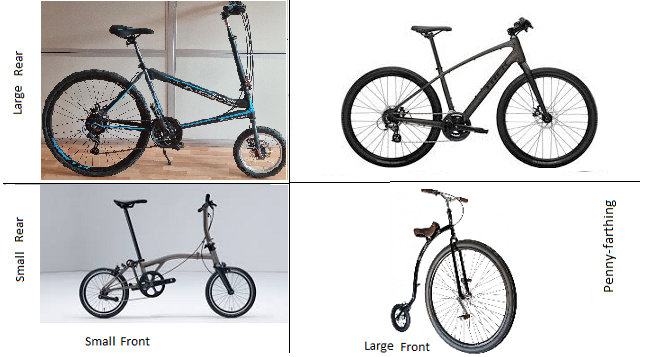
Usually, one of the most expensive component on a bike is the fork because it is long and tiny part, and must be rigid enough, so if you want better performance, you must spend more on the fork.
Smaller wheels are typically quicker to accelerate when compared to larger diameter ones, which is mainly a result of their lower weight that requires less effort to spin.
A larger diameter tires will have a lot more tread in contact with the terrain it is rolling over, than a smaller diameter tires provided that both are the same width, however you can get the same grip from a small but wide tire.
There’s also enhanced ride comfort larger tires have more air volume and longer wheel spokes acts a simple suspension, however this can be achieved with a suspension system as well.
In everyday non-professional use, 70% of the load is on the rear wheel and 30% of the weight is on the front wheel. Also typically the rear wheel is mounted from its center to the chassis frame and the front wheel is mounted from the top of it.
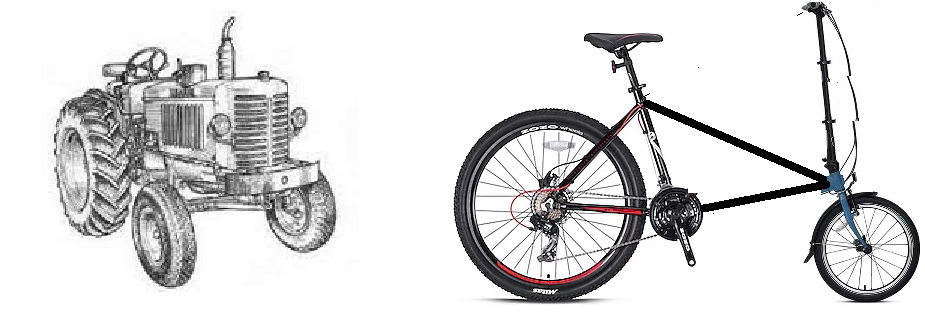
A factor that influences how easy or difficult a bike will be to ride is trail, the distance by which the front wheel ground contact point trails behind the steering axis ground contact point. The steering axis is the axis about which the entire steering mechanism (fork, handlebars, front wheel, etc.) pivots.
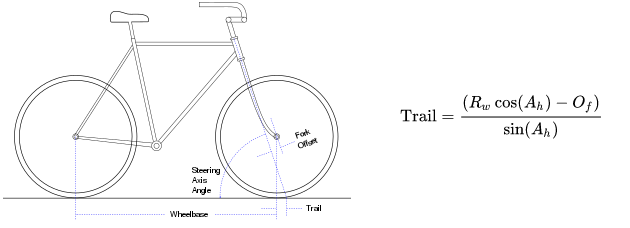
where Rw is wheel radius, Ah is the head angle measured clock-wise from the horizontal and Of is the fork offset or rake.
A small survey by Whitt and Wilson found:
- touring bicycles with head angles between 72° and 73° and trail between 43 mm and 60 mm
- racing bicycles with head angles between 73° and 74° and trail between 28 mm and 45 mm
- track bicycles with head angles of 75° and trail between 23.5 mm and 37 mm.
Trail can be decreased by decreasing the wheel size, inccreasing the head angle, or increasing the fork rake. The more trail a traditional bike has, the more stable it feels, although too much trail can make a bike feel difficult to steer.
However, i presume most of you experienced a scooter ride, small front wheeled single-track vehicles do not have this trade-off, and capable of cornering fast and quickly.
Benefits are:
Simple fork can provide high rigidness, because it is short. Do not need to make a design decision the trade-off between trail fork rake ( offset )
Little front tires but have a triangle formed frame chassis, provide maximum rigidness.
Big front wheel on front has a bigger gyroscopic force and resists to turning steering handlebar, little tires less gyroscopic force
Small tires enables disc plates diameter proportion higher and better disk breaks performence
More space available in front can be used for cargo carrying
Less space needed on parking next to wall, next to other bicycles eg. Turn handlebar 45 degrees
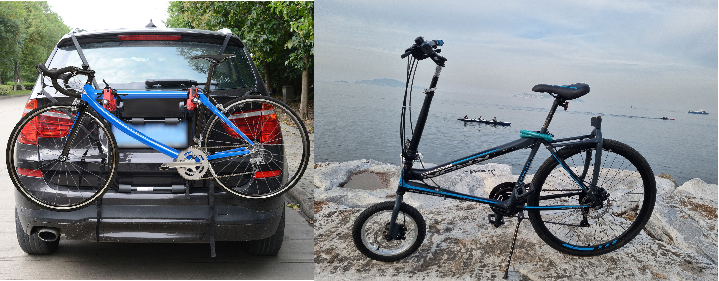
This design enables a bike overall size 18cm shorter than a regular one without decreasing wheelbase, which is not much but, when you carry your bike on a car mount carrier, this little centimeters are crucial.

Ladies with skirt or parents with a child seat attached back of bicycle, senior people might have difficulty to raise foot to start ride, and solution usually is another chassis frame variant:women’s bike. This proposeddesign also helps that.
Last and not the least : Little tires are cheaper
A foldable bike also have small front wheel however, because their frame consist of a line and the saddle is mounted on top of a long metal bar which many people feel not rigid enough. You can not install a child seat or a trailer to foldable bikes.
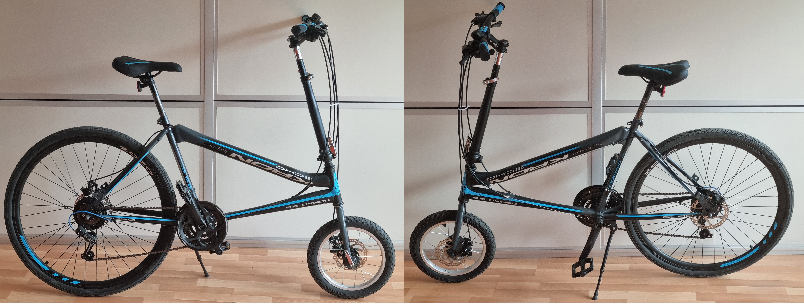
I’ve built this bike and at first it look a little strange because it is different. But now if you think design requirements, this is the normalized design, without need to resolve rigid fork, rigid chassis body, trail/offset trade off etc.
Besides benefits, it is much fun to ride this bike: Very quick and direct on cornering.